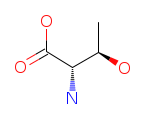Threonine
Threonine, the last essential dietary amino acid to be identified, was found in 1935 by William Cumming Rose. This amino acid supports the human immune system by helping in the production of antibodies.
Chemical Structure of L-Threonine

Identifiers and properties of Threonine
IUPAC Name: (2S,3R)-2-Amino-3-hydroxybutanoic acid
Symbol: Three-letter code - Thr. One-letter code - T
Molecular Weight (Molar Mass): 119.11916 g/mol
Molecular Formula (Structural Formula): C4H9NO3
Canonical SMILES: CC(C(C(=O)O)N)O
Isomeric SMILES: C[C@H]([C@@H](C(=O)O)N)O
InChIKey Identifier: AYFVYJQAPQTCCC-QYISKGLTDV
CAS Number: 72-19-5
MDL Number: MFCD00064270
Melting point: 256 °C
RNA codons: ACA, ACC, ACG, ACT
Solubility in water: 90 g/L (20 °C); pKa - 2,09; pKb - 9,10
Rf value in n-butanol/acetic acid/water = 12:3:5 - 0.35
2D Molfile: Get the molfile
3D PDB file: Get the PDB file
Other names: (2S,3R)-2-Amino-3-hydroxybutyric acid; L-2-Amino-3-hydroxybutyric acid; (S)-Threonine
Functions of L-Threonine in the body
Threonine is an essential amino acid, i.e., it is vital for your health, but it canott be synthesized by your body and therefore has to be obtained from a diet. This amino acid supports central nervous, cardiovascular, liver, and immune system functioning - just to name a few. Moreover, it helps in the synthesis of glycine and serine which, in their turn, assist in the production of collagen, elastin, and muscle tissue. In addition, Threonine aids building strong bones and tooth enamel and speeds up a wound healing process after trauma or surgery by boosting up the immune system.
Threonine works the following way: it combines with aspartic acid and Methionine to jointly help liver digest fats and fatty acids. This process helps reduce the accumulation of fat in the liver, which would otherwise affect the liver function. This amino acid is also useful in treating Lou Gehrig's disease, aka Amyotrophic Lateral Sclerosis. Scientific researches show that Threonine treatment also helps alleviate symptoms of Multiple Sclerosis - another disease affecting nerves and muscles. Besides, Threonine is recognized as an immunostimulant promoting the growth of thymus gland.
Benefits of Threonine
Since Threonine is found largely in the central nervous system, it can be really helpful in treating different types of depression. This amino acid makes up elastin, collagen, and enamel protein, and even promotes the proper fat metabolism in the liver. Finally, Threonine is known for aiding the digestive and intestinal tracts to function more smoothly, as well as for helping in metabolism and assimilation.
Food sources
Proper levels of Threonine can be found in most meats, dairy and eggs. Vegans may obtain it from the wheat germ, nuts, beans and some vegetables, but in lower quantities. Here are some food sources that contain threonine along with approximate amounts per serving.
Meat and Poultry. Chicken Breast: A 3-ounce (85-gram) serving of roasted chicken breast provides approximately 1.3 grams of threonine. Turkey: A 3-ounce (85-gram) serving of cooked turkey contains around 1.2 grams of threonine.
Fish. Tuna: A 3-ounce (85-gram) serving of cooked tuna provides about 1.1 grams of threonine. Salmon: Similar to tuna, salmon contains around 1.2 grams of threonine per 3-ounce (85-gram) serving.
Dairy Products. Milk: One cup of milk contains about 0.6 grams of threonine. Yogurt: A typical 6-ounce serving of yogurt contains around 1.4 grams of threonine.
Eggs. One large egg provides approximately 0.6 grams of threonine.
Legumes. Soybeans: A 1-cup serving of cooked soybeans contains around 1.8 grams of threonine. Lentils: A 1-cup serving of cooked lentils provides about 0.7 grams of threonine.
Nuts and Seeds. Sunflower Seeds: A 1-ounce (28-gram) serving of sunflower seeds contains approximately 0.6 grams of threonine. Pumpkin Seeds: Pumpkin seeds provide around 0.5 grams of threonine per ounce.
Seafood. Shrimp: A 3-ounce (85-gram) serving of cooked shrimp provides around 0.9 grams of threonine. Crab: Crab is another seafood source with approximately 1.1 grams of threonine per 3-ounce (85-gram) serving.
Cabbage Family Vegetables. Spinach: A 1-cup serving of cooked spinach contains about 0.3 grams of threonine.
These values are approximate and can vary based on factors such as cooking methods, specific varieties of food, and preparation techniques. If you have specific health concerns or conditions that may require additional threonine, it's advisable to consult with a healthcare professional or a registered dietitian for personalized advice.